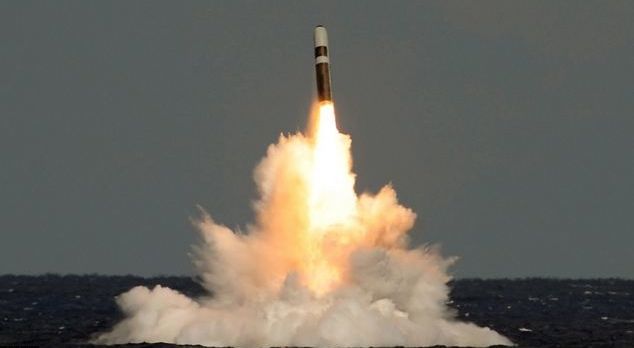Fading Solid Fuel Engine Biz Threatens Navy’s Trident Missile
Posted on

CAPITOL HILL: “Failure to launch” isn’t a metaphorical concern when you work on nuclear weapons. That’s why the director of the Navy’s euphemistically named Strategic Systems Program (SSP) is a worried man. What has Vice Adm. Terry Benedict worried is something neither he, nor the Navy nor the entire Defense Department directly control. It’s the viability of what Benedict called “an already fragile industry” that produces the solid-fuel rocket boosters for the Navy’s Trident submarine-launched ballistic missile (SLBM). The worst part is that the solid fuel rocket engine business is an industry that will live or die not on the military’s own decisions, but on NASA’s.
“NASA is the large procurer in this whole equation, so what NASA does affects everyone,” from the Navy to the custodian of the nation’s spy satellites, the National Reconnaissance Organization, Benedict told me after the Peter Huessy Congressional Breakfast here. The retirement of the Space Shuttle already hit US rocket-motor manufacturers hard and raised prices for the industry’s remaining customers, including the Trident program. Yes, in theory you could import rocket boosters from abroad, but in practice the big seller is Russia, which is a problematic partner on rocket programs (and other things) right now. “I don’t think we’d ever procure Trident motors outside the United States,” Benedict said bluntly when I raised the prospect.
Next, in 2016, NASA will decide whether its new boosters will use liquid fuel, solid propellant, or a mix. If they go all or mostly liquid, that’s a potential death blow for domestic solid fuel manufacturing, and the Trident’s a solid-fuel missile. Even if the Navy could afford to design a replacement, it would still have to use solid propellant, because liquid rocket fuel is simply unsafe in the tight confines of a submarine.
That’s a unique Navy dilemma. In the Air Force ICBM program, for instance, “they do use liquids today in their upper stage,” Benedict told me. “Liquid [fuels] are a prohibited item on submarines.”
This isn’t a problem Benedict or his bosses at the Pentagon can fix by themselves. “I don’t think this is an SSP issue, an Navy issue, a Department of Defense issue: This is a national issue,” Benedict said. “If you want to have that capability, it should not be on SSP’s back” to keep the industry alive until someone else decides to start buying again.
That sounds awfully similar to the argument that Benedict’s shipbuilding colleagues make about the submarine that will carry the Tridents when the current Ohio-class SSBN becomes too old to operate in the 2030s: The Ohio Replacement Program (formerly SSBN(X)) is too expensive and too important for the Navy budget to have to carry alone, they argue. Congressional supporters are moving to set up a special account for ORP outside the Navy budget, but actually finding the funding will be much harder.
The service has already decided to save money by pouring old wine into new bottles. It will equip the future sub with the existing Trident D-5 missile — already 25 years old this December — rather than design a new one. That plan will keep the D-5 in service “more than twice as long as any previous missile program,” Benedict told the breakfast audience. “We will be entering uncharted territory.”
It’s up to Benedict and SSP to keep the Trident functional for decades to come. They’re working hard on overhauling and replacing aging components, from the flight controls to the navigation system to the rocket motor. SSP is buying least 12 new boosters a year to replace ones getting too old to safely use. (Trident fuel contains nitroglycerine and, unlike wine and cheese, definitely does not improve with age). But SSP is a relatively small player in the rocket motor market.
So what’s Plan B? If the Navy can’t convince NASA to keep buying solid propellant, maybe it can convince the Air Force to do so when it eventually builds the new Ground-Based Strategic Deterrent. Currently the Air Force has fully modernized its inventory of rocket motors and stopped procurement, Benedict said, but it is conducting an official Analysis Of Alternatives (AOA) for the future GBSD missile, and Benedict’s staff are participating.
“In the past, it’s been, ‘the Navy designs SLBMs, the Air Force designs ICBMs, and never shall they talk,'” Benedict said at breakfast. “I’m trying to break down those walls….We should be required to talk at the design and development phase.”
There are even commercial users of solid propellant — but they use lower-powered varieties than the Navy requires, so a single formula won’t work for civilians, sailors, and Air Force missileers. “You’d love it to be common across everybody; I’m not sure that’s realistic,” Benedict said. “But can we create a propellant mix that uses common constituents, so that we can get the cost advantage of bulk buys, and then mix them potentially in slightly different formulations [for each user]? That’s exactly the R&D that we’re running with the Air Force and with industry right now, and quite frankly it’s giving us some pretty positive returns.”
Subscribe to our newsletter
Promotions, new products and sales. Directly to your inbox.
